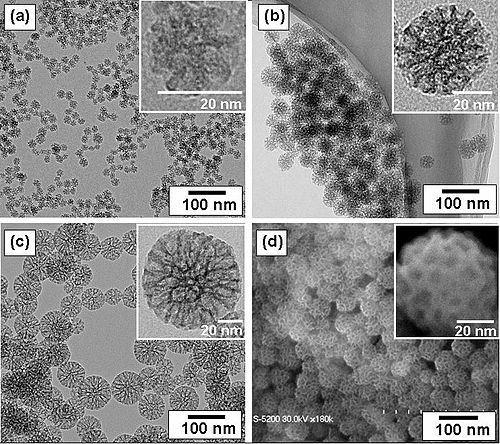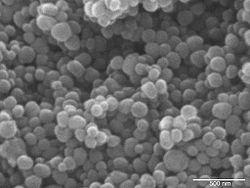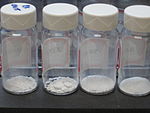- Mesoporous silica
-
General information Name: Mesoporous silica Appearance: fine white powder Types: MCM-41, SBA-15, MSU-, KSW-, FSM-, HMM- Main component: amorphous silica Mesoporous silica is a form of silica and a recent development in nanotechnology. The most common types of mesoporous nanoparticles are MCM-41 and SBA-15.[1] Research continues on the particles, which have applications in catalysis, drug delivery and imaging.[2]
Contents
History
 TEM image of a mesoporous silica nanoparticle
TEM image of a mesoporous silica nanoparticle
A procedure for producing mesoporous silica was patented around 1970.[3][4][5] It went almost unnoticed[6] and was reproduced in 1997.[7] Mesoporous silica nanoparticles (MSNs) were independently synthesized in 1990 by researchers in Japan.[8] They were later produced also at Mobil Corporation laboratories [9] and named Mobil Crystalline Materials, or MCM-41.[10]
Six years later, silica nanoparticles with much larger 4.6 to 30 nanometer pores were produced at the University of California, Santa Barbara.[11] The material was named Santa Barbara Amorphous type material, or SBA-15. These particles also have a hexagonal array of pores.
The researches who invented these types of particles planned to use them as molecular sieves. Today, mesoporous silica nanoparticles have many applications in medicine, biosensors, and imaging.
Synthesis
Mesoporous silica nanoparticles are synthesized by reacting tetraethyl orthosilicate with a template made of micellar rods. The result is a collection of nano-sized spheres or rods that are filled with a regular arrangement of pores. The template can then be removed by washing with a solvent adjusted to the proper pH.[2]
In another technique, the mesoporous particle could be synthesized using a simple sol-gel method[12] or a spray drying method.[13] Tetraethyl orthosilicate is also used with an additional polymer monomer (as a template).
Drug delivery
The large surface area of the pores allows the particles to be filled with a drug or a cytotoxin. Like a Trojan Horse, the particles will be taken up by certain biological cells though endocytosis, depending on what chemicals are attached to the outside of the spheres. Some types of cancer cells will take up more of the particles than healthy cells will, giving researchers hope that MCM-41 will one day be used to treat certain types of cancer.[2]
Ordered mesoporous silica (e.g. SBA-15,[14] TUD-1,[15] HMM-33,[12] and FSM-16[16]) also show potential to boost the in vitro and in vivo dissolution of poorly water soluble drugs. Many drug-candidates coming from drug discovery suffer from a poor water solubility. An insufficient dissolution of these hydrophobic drugs in the gastrointestinal fluids strongly limits the oral bioavailability. One example is itraconazole which is an antimycoticum known for its poor aqueous solubility. Upon introduction of itraconazole-on-SBA-15 formulation in simulated gastrointestinal fluids, a supersaturated solution is obtained giving rise to enhanced transepithelial intestinal transport.[17] Also the efficient uptake into the systemic circulation of SBA-15 formulated itraconazole has been demonstrated in vivo (rabbits and dogs).[18] This approach based on SBA-15 yields stable formulations[19] and can be used for a wide variety of poorly water soluble compounds.[20]
Biosensors
The structure of these particles allows them to be filled with a fluorescent dye that would normally be unable to pass through cell walls. The MSN material is then capped off with a molecule that is compatible with the target cells. When the MSNs are added to a cell culture, they carry the dye across the cell membrane. These particles are optically transparent, so the dye can be seen through the silica walls. The dye in the particles does not have the same problem with self-quenching that a dye in solution has. The types of molecules that are grafted to the outside of the MSNs will control what kinds of biomolecules are allowed inside the particles to interact with the dye.[21][22]
Gallery
 TEM (a, b, and c) images of HMM with mean outer diameter: (a) 20nm, (b) 45nm; and (c) 80nm. SEM (d) image corresponding to (b).[12]
TEM (a, b, and c) images of HMM with mean outer diameter: (a) 20nm, (b) 45nm; and (c) 80nm. SEM (d) image corresponding to (b).[12]
See also
References
- ^ Katiyar, Amit; Yadav, Santosh; G, Panagiotis; Neville, Smirniotis; Pinto, G (2006). "Synthesis of ordered large pore SBA-15 spherical particles for adsorption of biomolecules". Journal of Chromatography 1122 (1-2): 13–20. doi:10.1016/j.chroma.2006.04.055. PMID 16716334.
- ^ a b c Trewyn, Brian G; Nieweg, Jennifer A; Zhao, Yannan; Lin, Victor S.-Y. (2007). "Biocompatible mesoporous silica nanoparticles with different morphologies for animal cell membrane penetration". Chemical Engineering Journal 137 (137): 23–29. doi:10.1016/j.cej.2007.09.045.
- ^ Chiola, V.; Ritsko, J. E. and Vanderpool, C. D. "Process for producing low-bulk density silica." Application No. US 3556725D A filed on 26-Feb-1969; Publication No. US 3556725 A published on 19-Jan-1971
- ^ "Porous silica particles containing a crystallized phase and method" Application No. US 3493341D A filed on 23-Jan-1967; Publication No. US 3493341 A published on 03-Feb-1970
- ^ "Process for producing silica in the form of hollow spheres"; Application No. US 342525 A filed on 04-Feb-1964; Publication No. US 3383172 A published on 14-May-1968
- ^ Ruren Xu, Wenqin Pang, Jihong Yu (2007). Chemistry of zeolites and related porous materials: synthesis and structure. Wiley-Interscience. p. 472. ISBN 0470822333. http://books.google.com/books?id=kn1dSnP4nesC&pg=PA472.
- ^ Direnzo, F; Cambon, H; Dutartre, R (1997). "A 28-year-old synthesis of micelle-templated mesoporous silica". Microporous Materials 10 (4-6): 283. doi:10.1016/S0927-6513(97)00028-X.
- ^ Yanagisawa, Tsuneo; Shimizu, Toshio; Kuroda, Kazuyuki; Kato, Chuzo (1990). "The preparation of alkyltrimethylammonium-kanemite complexes and their conversion to microporous materials." (free download). Bulletin of the Chemical Society of Japan 63 (4): 988. doi:10.1246/bcsj.63.988.
- ^ J. S. Beck; J. C. Vartuli; W. J. Roth; M. E. Leonowicz; C. T. Kresge; K. D. Schmitt; C. T-W. Chu; D. H. Olson; E. W. Sheppard; S. B. McCullen; J. B. Higgins; and J. L. Schlenkert (1992). "A New Family of Mesoporous Molecular Sieves Prepared with Liquid Crystal Templates". American Chemical Society 114 (114): 10834–10843. doi:10.1021/ja00053a020.
- ^ Brian Trewyn, et al. (2007). "Synthesis and Functionalization of a Mesoporous Silica Nanoparticle Based on the Sol–Gel Process and Applications in Controlled Release". Accounts of Chemical Research 40 (9): 846–853. doi:10.1021/ar600032u. PMID 17645305.
- ^ Dongyuan Zhao, et al. (1998). "Triblock Copolymer Syntheses of Mesoporous Silica with Periodic 50 to 300 Angstrom Pores". Science 279 (5350): 548. doi:10.1126/science.279.5350.548. PMID 9438845.
- ^ a b c A.B.D. Nandiyanto; S.-G Kim; F. Iskandar; and K. Okuyama (2009). "Synthesis of Silica Nanoparticles with Nanometer-Size Controllable Mesopores and Outer Diameters". Microporous and Mesoporous Materials 120 (3): 447–453. doi:10.1016/j.micromeso.2008.12.019.
- ^ A. B. D. Nandiyanto; F. Iskandar; and K. Okuyama (2008). "Nano-sized Polymer Particle-Facilitated Preparation of Mesoporous Silica Particles Using a Spray Method". Chemistry Letters 37 (10): 1040. doi:10.1246/cl.2008.1040.
- ^ Mellaerts, Randy; Aerts, Caroline A.; Humbeeck, Jan Van; Augustijns, Patrick; Den Mooter, Guy Van; Martens, Johan A. (2007). "Enhanced release of itraconazole from ordered mesoporous SBA-15 silica materials". Chemical Communications (13): 1375. doi:10.1039/b616746b. PMID 17377687.
- ^ Heikkila, T; Salonen, J; Tuura, J; Hamdy, M; Mul, G; Kumar, N; Salmi, T; Murzin, D et al. (2007). "Mesoporous silica material TUD-1 as a drug delivery system". International Journal of Pharmaceutics 331 (1): 133. doi:10.1016/j.ijpharm.2006.09.019. PMID 17046183.
- ^ Tozuka, Yuichi; Wongmekiat, Arpansiree; Kimura, Kyoko; Moribe, Kunikazu; Yamamura, Shigeo; Yamamoto, Keiji (2005). "Effect of Pore Size of FSM-16 on the Entrapment of Flurbiprofen in Mesoporous Structures". Chemical & Pharmaceutical Bulletin 53 (8): 974. doi:10.1248/cpb.53.974.
- ^ Mellaerts, Randy; Mols, Raf; Kayaert, Pieterjan; Annaert, Pieter; Van Humbeeck, Jan; Van Den Mooter, Guy; Martens, Johan A.; Augustijns, Patrick (2008). "Ordered mesoporous silica induces pH-independent supersaturation of the basic low solubility compound itraconazole resulting in enhanced transepithelial transport". International Journal of Pharmaceutics 357 (1-2): 169. doi:10.1016/j.ijpharm.2008.01.049. PMID 18325700.
- ^ Mellaerts, Randy; Mols, Raf; Jammaer, Jasper A.G.; Aerts, Caroline A.; Annaert, Pieter; Van Humbeeck, Jan; Van Den Mooter, Guy; Augustijns, Patrick et al. (2008). "Increasing the oral bioavailability of the poorly water soluble drug itraconazole with ordered mesoporous silica". European Journal of Pharmaceutics and Biopharmaceutics 69 (1): 223. doi:10.1016/j.ejpb.2007.11.006. PMID 18164930.
- ^ Mellaerts, Randy; Houthoofd, Kristof; Elen, Ken; Chen, Hong; Van Speybroeck, Michiel; Van Humbeeck, Jan; Augustijns, Patrick; Mullens, Jules et al. (2010). "Aging behavior of pharmaceutical formulations of itraconazole on SBA-15 ordered mesoporous silica carrier material". Microporous and Mesoporous Materials 130: 154. doi:10.1016/j.micromeso.2009.10.026.
- ^ Van Speybroeck, Michiel; Barillaro, Valéry; Thi, Thao Do; Mellaerts, Randy; Martens, Johan; Van Humbeeck, Jan; Vermant, Jan; Annaert, Pieter et al. (2009). "Ordered mesoporous silica material SBA-15: A broad-spectrum formulation platform for poorly soluble drugs". Journal of Pharmaceutical Sciences 98 (8): 2648. doi:10.1002/jps.21638. PMID 19072861.
- ^ Trewyn, Brian G; Supratim, Giri; Slowing, Igor I; Lin, Victor S.-Y. (2007). "Mesoporous silica nanoparticle based controlled release, drug delivery, and biosensor systems". Chemical communications (31): 3236–3245. doi:10.1039/b701744h. PMID 17668088.
- ^ Radu, Daniela R; Lai, Chen-Yu; Jeftinija, Ksenija; Rowe, Eric W; Jeftinija, Srdija; and Lin, Victor S.-Y. (2004). "A Polyamidoamine Dendrimer-Capped Mesoporous Silica Nanosphere-Based Gene Transfection Reagent". Journal of the Americal Chemical Society 126 (41): 13216–13217. doi:10.1021/ja046275m. PMID 15479063.
Categories:
Wikimedia Foundation. 2010.


